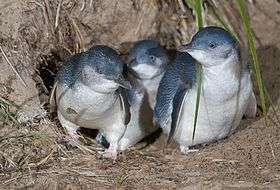Phillip Island Important Bird Area

The Phillip Island Important Bird Area comprises a 20 km2 strip of coastline along the south and west coasts of Phillip Island, Victoria, in south-eastern Australia.
Description
The site contains much of the Phillip Island Nature Park, including the tourist attraction of Penguin Parade, the headland of Cape Woolamai, sandy beaches, coastal vegetation of herbland, grassland and shrubland, and the offshore islets and reefs of the Nobbies and Seal Rocks at the western end of the island. It does not include the intertidal mudflats of the island’s north-eastern coast, which are part of the Western Port Important Bird Area.[1]
Birds
The site has been identified by BirdLife International as an Important Bird Area (IBA) because it supports over 1% of the world populations of little penguins (with up to 26,000 birds), short-tailed shearwaters (up to 450,000 pairs) and Pacific gulls (with an estimated 52-490 birds). In the past it was occasionally visited by small numbers of orange-bellied parrots.[2] One of the largest breeding colonies of crested terns in Victoria (2800 pairs) is at the Nobbies. Pied and sooty oystercatchers, as well as hooded plovers, use the beaches.[1]
Seals
Seal Rocks has the second largest colony in the world of Australian fur seals, with some 20,000-25,000 seals (25-30% of the global population) breeding or hauling-out there.[1]
References
- 1 2 3 BirdLife International. (2011). Important Bird Areas factsheet: Phillip Island. Downloaded from http://www.birdlife.org on 2011-09-17.
- ↑ "IBA: Phillip Island". Birdata. Birds Australia. Retrieved 2011-09-17.
Coordinates: 38°31′11″S 145°12′46″E / 38.51972°S 145.21278°E